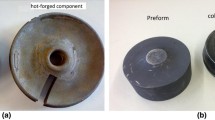Abstract
In this study, the distortion of steel shafts was investigated before and after induction hardening. Several essential influencing factors in the manufacturing process chain regarding cold drawing, cutting method, notches on the shafts, and induction hardening were analyzed by design of experiment (DoE). Further necessary examinations of microstructures, hardness profile, segregation of chemical composition, and residual stress state were conducted for understanding the distortion behavior. The results of the statistical analysis of the DoE showed that the drawing process is the most important factor influencing distortion. The surface hardening depth of induction hardening is the second main factor. The relationship between inhomogeneities in the work pieces and the distortion was finally discussed.

















Similar content being viewed by others
References
F. Hoffmann, O. Keßler, T. Luebben, P. Mayr: Heat Treatment of Metals, 29 (2004) 8, pp. 61-66.
O. Keßler, C. Prinz, T. Sackmann, L. Nowag, H. Surm, F. Frerichs, T. Luebben and H.W. Zoch: Materialwiss. Werkstofftech. 2006, vol. 37, pp.11-18, doi: 10.1002/mawe.200500975.
Z. Wang, B. Gong: ASM Handbook of residual stress and deformation of steel, ASM International, USA, 2002, pp.141-49.
K.D. Thoben, T. Luebben, B. Clausen, C. Prinz, and A. Schulz: Proc. 4th Int. Conf. Quenching and Control of Distortion, Beijing, China, 20–23 May 2003, pp. 325–31, http://search.proquest.com/docview/27850729?accountid=14136.
N.B. Khalifa: Report of the research IGF 309ZN, Dortmund, Germany, Jan. 2012.
H.W. Zoch: Materialwiss. Werkstofftech. 2006, vol. 37, pp. 6-10, doi:10.1002/mawe.200500958.
H.W. Zoch and T. Luebben: Proc. 6th Int. Quenching and Control of Distortion Conf., Chicago, USA, 2012, pp. 1–11.
K. Siebertz, D. van Bebber, and T. Hochkirchen: Statistische Versuchsplanung—Design of Experiments (DoE), Springer, Berlin, 2010. e-ISBN 978-3-642-05493-8, DOI:10.1007/978-3-642-05493-8.
W. Kleppmann: Taschenbuch Versuchsplanung, Carl Hanser Verlag, Munich, Vienna, 2001.
H. Surm, O. Kessler, F. Hoffmann and P. Mayr: Int. J. Mater. Prod. Technol., 2005, vol. 24, pp. 270-81, doi:10.1504/IJMPT.2005.007954.
F. Frerichs, Th. Luebben, F. Hoffmann and P. Mayr: Int. J. Materials and Product Technology, 2005, vol. 24, pp. 244–58, doi:10.1504/IJMPT.2005.007952.
I.C. Noyan and J.B. Cohen: Residual stress, measurement by diffraction and interpretation, Springer, New York, 1987.
J. Epp, T. Hirsch: Materialwiss. Werkstofftech. 2012, vol. 43, pp. 112-19, doi:10.1002/mawe.201100897.
M. L. Martinez-Peres, F.J. Mompean, J. Ruiz-Hervias, C.R. Borlado, J.M. Atenzia, M. Garcia-Hernandez, M. Elices, J. Gil-Sevillano, R.L. Peng and T. Buslaps: Acta Mater., 2004, vol. 52, pp. 5303-13.
K. van Acker, J. Root, P. van Houte, and E. Aernoudt: Acta mater., 1996, vol. 10, pp. 4039-44.
J. Dong, J. Epp, A. Rocha, R.M. Nunes, R. Wimpory and H.W. Zoch: HTM J. Heat Treat. Mater., 2014, vol. 69, pp. 348-359. doi:10.3139/105.110244.
R. A. Grange: ASM Trans. Quert. 59 (1966) 1, pp. 26-48.
G. Krauss: Materials Science and Engineering A273–275 (1999), pp. 40–57.
H. Fahry, H.-W. Zoch, H. Schlicht: HTM Haerterei-Tech. Mitt. 1989, vol. 44, pp. 149-56.
S. Haenisch, S. Ossenkemper, A. Jaeger, N.B. Khalifa, A.E. Tekkaya, D. Nadolski, A. Schulz, F. Hoffmann, and H.W. Zoch: Proceedings of the 45th ICFG Plenary Meeting, Nagoya, Japan, 9–12 September 2012, pp. 32–38.
A.S. Rocha, R.M. Nunes, T.F. Souza, C.A.T. Soares, A. E. Tekkaya, and T. Hirsch: HTM, J. Heat Treat. Mater., 2013, vol. 68, pp. 135–141, DOI:10.3139/105.110187.
T. Hirsch, A.S. Rocha and R.M. Nunes: Metall. Mater. Trans. A, 2013, vol. 44A, pp. 5806-16, DOI:10.1007/s11661-013-1952-z.
D. Nadolski, S. Haenisch, A. Schulz, N.B. Khalifa, F. Hoffmann, H.W. Zoch, and A.E. Tekkaya: 3rd Int. Conf. Distortion Engineering, 2011, Bremen, Germany, 14–16 September, 2011, pp. 267–274.
Acknowledgments
This work was done in the frame of the “BRAGECRIM” program (Brazilian German Cooperation Research Initiative in Manufacturing). The authors are deeply indebted to DFG, CAPES, and CNPq for financial support. This research also has been supported by the European Commission under the 7th Framework Program through the Key Action: Strengthening the European Research Area, Research Infrastructures: Contract No. 226507 (NIMI3).
Author information
Authors and Affiliations
Corresponding author
Additional information
Manuscript submitted July 7, 2015.
Rights and permissions
About this article
Cite this article
Dong, J., Epp, J., Rocha, A. et al. Investigation of the Influence Factors on Distortion in Induction-Hardened Steel Shafts Manufactured from Cold-Drawn Rod. Metall Mater Trans A 47, 877–888 (2016). https://doi.org/10.1007/s11661-015-3250-4
Published:
Issue Date:
DOI: https://doi.org/10.1007/s11661-015-3250-4




